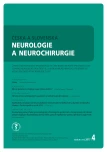Comment of Article The Effect of Different Occupational Therapy Techniques on Post-stroke Patients
Published in the journal:
Cesk Slov Neurol N 2017; 80/113(4): 469
Category:
Komentář k článku
The article describes two methods of modern rehabilitation after stroke and compares the effects of occupational therapy using these two methods within the evidence-based medicine.
Constraint-induced movement therapy is recommended for paresis, which is retained partial mobility of affected extremities. Now it is proven to have a therapeutic effect after 30 min of treatment per day (compared with the previous 20 to 22 hours of therapy per day) [1].
Mirror therapy is a simple, excellent therapeutic method. It is a new rehabilitation strategy that has been proposed as a means therapy of stroke. Mirror therapy is also suitable for patients with total plegia limbs. It is a neuro-rehabilitation technique designed to remodulate cortical brain mechanisms. With this technique, patients perform movements using the unaffected limb whilst watching its mirror reflection superimposed over the (unseen) affected limb. This creates a visual illusion and provides positive feedback to the motor cortex that movement of the affected limb has occurred. The approach is thought to offer potential to improve function through the visual dominance upon motor and sensory processes [2].
Mirror therapy is recommended in both acute and chronic phases of rehabilitation after stroke [3]. Mirror therapy offers an easy-to-use, very effective and low-cost adjuvant therapeutic rehabilitation technique.
Petr Konečný, MD, Ph.D.
Department of Physiotherapy,
Faculty of Health Sciences Palacký University Olomouc
e-mail: Pet.Konecny@centrum.cz
Zdroje
1. Etoom M, Hawamdeh M, Hawamdeh Z, et al. Constraint-induced movement therapy as a rehabilitation intervention for upper extremity in stroke patients: systematic review and meta-analysis. Int J Rehabil Res 2016;39(3):197– 210. doi: 10.1097/ MRR.0000000000000169.
2. Chang MY, Kim HH, Kim KM, et al. Effects of observation of hand movements reflected in a mirror on cortical activation in patients with stroke. J Phys Ther Sci 2017;29(1):38– 42. doi: 10.1589/ jpts.29.38.
3. Perez-Cruzado D, Merchan-Baeza JA, Gonzalez-San-chez M, et al. Systematic review of mirror therapycompared with conventional rehabilitation in upperextremity function in stroke survivors. Aust OccupTher J 2017;64(2):91– 112. doi: 10.1111/ 1440-1630.12342.
Štítky
Detská neurológia Neurochirurgia NeurológiaČlánok vyšiel v časopise
Česká a slovenská neurologie a neurochirurgie

2017 Číslo 4
- Metamizol jako analgetikum první volby: kdy, pro koho, jak a proč?
- MUDr. Lenka Klimešová: Multiodborová vizita je kľúč k efektívnejšej perioperačnej liečbe chronickej bolesti
- Realita liečby bolesti v paliatívnej starostlivosti v Nemecku
Najčítanejšie v tomto čísle
- Czech National Guillain-Barré Syndrome Registry
- Clinical View of the Otorhinolaryngologist and Radiologist on the Classification of Fractures of the Temporal Bone
- The Czech Pneumological and Physiological Society and the Czech Society for Paediatric Pulmonology Guidelines for Long-term Home Treatment Using the CoughAssist Machine in Patients with Serious Cough Disorders
- Nerve Injuries in Supracondylar Humeral Fractures in Children
